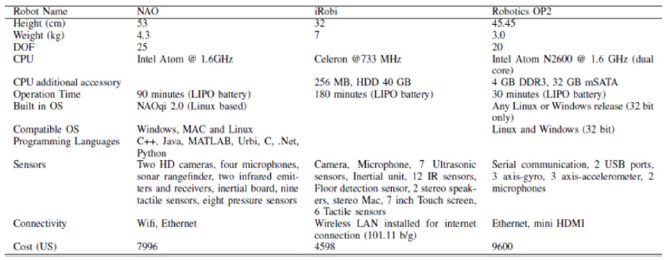
Lupine Publishers Group
Lupine Publishers
Menu
ISSN: 2643-6736
Short Communication(ISSN: 2643-6736) 
Use of Latest Robots for Autism Spectrum Disorder Volume 1 - Issue 2
Sara Ali*, Yasar Ayaz and Muhammad Jawad Khan
- Department of Robotics and Intelligent Machine Engineering, SMME, National University of Sciences and Technology, Pakistan
Received: September 28, 2018; Published: October 03, 2018
*Corresponding author: Sara Ali, Department of Robotics and Intelligent Machine Engineering, SMME, National University of Sciences and Technology, Islamabad, Pakistan
DOI: 10.32474/ARME.2018.01.000108
Abstract
One of the prominent applications of robots is in assistive therapy using humanoids. Robots are now playing a vital role in our lives as assistants, therapist, companions and much more. Autism Spectrum Disorder (ASD) affects the communication skills and social cues of a person considerably. Recently efforts have been made in the development of communicational, behavioral, motor movements, joint attention and physical behavior of the children suffering from ASD using the humanoid robots. The therapies based on interactive interventions using robots for ASD have proved to be a favorable tool for improving the behavior of children with ASD. There are different ways to identify and improve the behavior in ASD child e.g. psychologists’ sessions, computer vision based bio markers like joint attention measurement and gait analysis, and robot assisted therapies using Autism Observation Scale for Infants (AOSI). In particular the area of robotics is helping a lot in the treatment of ASD as the robot acts as a mediator as well as measures the response of an autistic child.
Keywords: Autism; Joint Attention; Therapy; Bio Markers
Introduction
for the treatment of Autism spectrum disorder. The SAR aims at improving the social response and communication skills of an individual suffering with social disabilities. One of the most commonly addressed disabilities by the humanoid robots is Autism Spectrum Disorder (ASD) [1]. Impairment in social interactions and communication skills caused by a complex developmental brain disorder refers to the definition of Autism Spectrum Disorder [2]. Children under ASD lack verbal, non-verbal and communication skills such as joint attention, imitation, gait, motor skills, facial expressions etc. With the advancement in recent years, robots are now replacing human tasks with a lot of accuracy, reliability, different aesthetic and functional characteristics. Robots have now been interacting with ASD children under specially designed interactive interventions for improving the social cues and behavior of ASD child. There are several robots that have been made to develop social development skills or physical impairments. Research shows that robots helps to improve the attention span and develop the spontaneous skills of a child with ASD [3,4]. Examples of such robots are Paro [5-7], robotic doll Robot [8-11]. These robots help people with physical, emotional and behavioral disorders to improve their social interaction and cues.
Robots Utilized in ASD Interventions
There are multiple robots which have been developed and utilized in Autism Spectrum Disorder curing. Few of them are given in Table 1, which are listed along with their specifications. Among all, NAO is more famous and it’s being utilized in different applications along with Autism Spectrum Disorder.
References
- S Mohammad Mavadati, Huanghao Feng, Anibal Gutierrez, Mohammad H Mahoor (2014) Comparing the Gaze Responses of Children with Autism and Typically Developed Individuals in Human-Robot Interaction. IEEE, Spain.
- S Baron Cohen (2004) The cognitive neuroscience of autism. Journal of Neurology, Neurosurgery & Psychiatry 75(7): 945-948.
- I Werry, K Dautenhahn, W Harwin (2001) Evaluating the response of children with autism to a robot, in Proc. of the RESNA 2001 Annual Conference, Rehabilitation Engineering and Assistive Technology Society of North America, Resna Press p.14-19.
- H Kozima, C Nakagawa, Y Yasuda (2007) Children-robot interaction: A pilot study in autism therapy. Progress in Brain Research 164: 385-400.
- K Wada, T Shibata (2006) Robot Therapy in a Care House-Its Sociopsychological and Physiological Effects on the Residents, in Proceedings of the International Conference on Robotics and Automation, pp. 3966-3971.
- P Marti, A Pollini, A Rullo, T Shibata (2005) Engaging with artificial pets, in Annual Conference of the European Association of Cognitive Ergonomics, Chania, Greece.
- H Kozima, H Yano (2001) Designing a robot for contingency detection game, in Workshop on Robotic and Virtual Interactive Systems in Autism Therapy.
- A Billard, B Robins, K Dautenhahn, J Nadel (2006) Building Robota, a Mini-Humanoid Robot for the Rehabilitation of Children with Autism, RESNA Assistive Technology Journal 19(1): 37-49.
- K Dautenhahn, A Billard (2002) Games Children with Autism Can Play with Robota, a Humanoid Robotic Doll, in Universal Access and Assistive Technology S Keates, et al. (Eds.); London: Springer-Verlag pp.179-190.
- B Robins, K Dautenhahn, J Dubowski (2006) Does appearance matter in the interaction of children with autism with a humanoid robot? Interaction studies: Social Behaviour and Communication in Biological and Artificial Systems 7(3): 509-542.
- K Dautenhahn, CL Nehaniv, ML Walters, B Robins, H Kose Bagci et al. (2009) KASPAR-A Minimally Expressive Humanoid Robot for Human- Robot Interaction Research, Special Issue on Humanoid Robots, Applied Bionics and Biomechanics 6(3-4): 369-397.

Top Editors
-

Mark E Smith
Bio chemistry
University of Texas Medical Branch, USA -

Lawrence A Presley
Department of Criminal Justice
Liberty University, USA -

Thomas W Miller
Department of Psychiatry
University of Kentucky, USA -

Gjumrakch Aliev
Department of Medicine
Gally International Biomedical Research & Consulting LLC, USA -

Christopher Bryant
Department of Urbanisation and Agricultural
Montreal university, USA -

Robert William Frare
Oral & Maxillofacial Pathology
New York University, USA -

Rudolph Modesto Navari
Gastroenterology and Hepatology
University of Alabama, UK -

Andrew Hague
Department of Medicine
Universities of Bradford, UK -

George Gregory Buttigieg
Maltese College of Obstetrics and Gynaecology, Europe -

Chen-Hsiung Yeh
Oncology
Circulogene Theranostics, England -
.png)
Emilio Bucio-Carrillo
Radiation Chemistry
National University of Mexico, USA -
.jpg)
Casey J Grenier
Analytical Chemistry
Wentworth Institute of Technology, USA -
Hany Atalah
Minimally Invasive Surgery
Mercer University school of Medicine, USA -

Abu-Hussein Muhamad
Pediatric Dentistry
University of Athens , Greece

The annual scholar awards from Lupine Publishers honor a selected number Read More...














